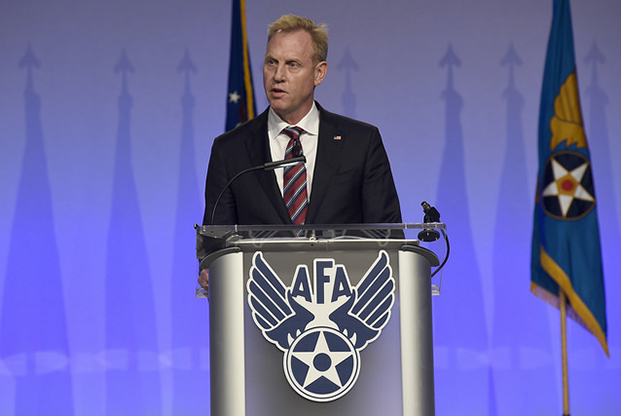
Dep?uty Defense Secretary Patrick Shanahan discussed the Space Force during a Sept. 19 keynote at AFA's Air, Space & Cyber Conference in National Harbor, Md. Staff photo by Mike Tsukamoto.
The forthcoming Space Force will need to start small—limited headquarters, limited red tape, and a large focus on accomplishing the mission by “doing no harm” to how the Air Force has handled the domain, the Pentagon’s No. 2 civilian said Wednesday.
Deputy Defense Secretary Patrick Shanahan, who was tasked with leading the Pentagon’s study on creating the separate military department of space operations, told an Air Force crowd at the Air Force Association’s 2018 Air, Space & Cyber Conference that a main goal in creating the service is to avoid hurting how effective USAF space operations have been, to avoid creating “seams” between the services, and to be “laser-focused” on what the warfighters need to be, to dominate in space.
“As we move forward, we will build upon incredible ingenuity and a good amount of the blood, sweat, and tears of a generation of airmen,” Shanahan said. “We need your expertise, passion, and creativity to succeed. Help us break new boundaries and continue to dominate in space.”
The Trump administration and the Pentagon in early August outlined its plan for the Space Force, starting with the creation of a separate combatant command for space operations before a new department is approved.
There isn’t a “playbook” to follow on how to create a new service, since the last time it occurred was with the creation of the Air Force in 1947. The Pentagon doesn’t have a lot of time to think through the large changes that are coming, since the deadline is coming soon.
“Over a very short period of time, it’s been thrust upon us to create and grow a new organization,” Shanahan said.
The Air Force last week sent a memo to Defense Department officials outlining what it thinks should be the responsibilities and structure of the Space Force, including an estimate that it would require 13,000 employees at a cost of $3.3 billion in its first year.
The Pentagon’s plan is for the initial Space Command to develop warfighting doctrine and tactics, techniques, and procedures, while a new Space Development Agency will support new product development, Shanahan said.
The Space Force will follow, with the goal of standing up the department no later than 2020. The Pentagon is finalizing its legislative proposal for this, expected to be rolled out with the Fiscal 2020 budget request in February. There’s been a lot of “serious thinking” on how to create this proposal. While much of the public discussion has been focused on things like uniforms and rank structure, Shanahan said the internal focus is on the capabilities that need to be delivered, and how to deliver them.